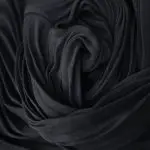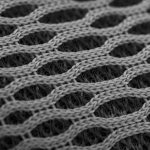When you consider chambray for your wardrobe, you might wonder about its durability and how long it'll last compared to other fabrics. While chambray is known for its comfort and breathability, its lighter weight raises questions about its overall longevity. You'll find that it holds up well against regular wear and washing, but there are nuances to its care that can significantly impact its lifespan. So, what should you know to make the most of your chambray pieces? The answer might surprise you.
Table of Contents
Key Takeaways
- Chambray is generally durable but lighter than denim, making it more prone to wear over time.
- Fabric weight, thread count, and weave density influence chambray's longevity; heavier and tightly woven options last longer.
- Regular washing and proper care can maintain chambray's integrity, preventing fading and shrinkage.
- Chambray is versatile and suitable for casual wear, providing comfort across various climates while resisting minor spills.
Understanding Chambray Fabric
Chambray fabric, often confused with denim, features a lightweight weave that combines colored threads for a versatile and stylish appearance. You'll notice that while denim has a heavier texture, chambray offers a softer feel, making it perfect for warm weather. The fabric typically consists of a colored warp thread and a white weft thread, creating a unique, heathered look that can easily elevate your wardrobe.
When you wear chambray, you'll appreciate its breathability and comfort, ideal for both casual and semi-formal occasions. It's commonly used in shirts, dresses, and even lightweight jackets, allowing for easy layering. You might find that chambray pieces blend seamlessly with various outfits, whether you pair them with jeans or chinos.
One factor to consider is its care. Chambray is usually machine washable, but always check the care label to maintain its appearance.
Composition and Quality Factors
When you consider chambray's durability, it's crucial to look at the fabric composition, as this significantly affects its quality.
The weaving techniques used also play a key role in how well the fabric holds up over time.
Plus, understanding care and maintenance tips can help you keep your chambray pieces looking fresh for longer.
Fabric Composition Analysis
Understanding the fabric composition of chambray reveals key quality factors that influence its durability and overall performance.
Typically, chambray is made from a blend of cotton and polyester, which contributes to its strength and resilience. Cotton provides breathability and comfort, while polyester enhances durability and resistance to wrinkles. This combination ensures that your chambray garments can withstand daily wear without losing their shape or integrity.
When you choose chambray, pay attention to the weight of the fabric. Heavier weights often indicate a more durable material, making it less prone to tearing or fraying. Additionally, the thread count can impact quality; higher thread counts generally mean a tighter weave, which boosts durability.
You should also consider the dyeing process. Chambray typically features a colored warp and a white weft, creating a unique appearance. If the dye is high-quality, it will resist fading over time, ensuring your chambray retains its vibrant look.
Weaving Techniques Impact
The weaving techniques used in chambray production significantly affect both its composition and overall quality. When you choose chambray, you're likely drawn to its unique blend of cotton fibers, but the way these fibers are woven together plays a crucial role in its durability. Typically, chambray is constructed using a plain weave, where the warp and weft threads cross over and under each other uniformly. This method creates a lightweight fabric that's both breathable and strong.
However, variations in weaving techniques can lead to differences in durability. For instance, a tighter weave often results in a more robust fabric that withstands wear better than a looser weave. If you're looking for chambray that can handle frequent washing or heavy use, pay attention to the weave density.
Additionally, some manufacturers may incorporate advanced weaving methods, like twill, which can enhance the fabric's resistance to fraying and fading. Ultimately, understanding the weaving techniques behind chambray will help you make informed choices about its longevity and overall quality, ensuring you select a piece that meets your needs.
Care and Maintenance Tips
To keep your chambray looking its best and extend its lifespan, follow some simple care and maintenance tips tailored to its fabric composition.
First, always check the care label for specific instructions, as different manufacturers might have varying recommendations. Generally, it's best to wash chambray in cold water to prevent shrinking and fading.
When you do wash it, turn the garment inside out to protect the outer layer. Use a gentle cycle and a mild detergent, avoiding bleach, which can damage the fabric's color and integrity.
For drying, air drying is ideal; if you must use a dryer, opt for a low heat setting.
Iron your chambray on a low setting while it's still slightly damp to help release any wrinkles without scorching the material. If you notice any stains, treat them promptly with a suitable stain remover, but test it first on a hidden area to avoid discoloration.
Lastly, store your chambray garments in a cool, dry place, preferably hanging or folded loosely to maintain their shape.
Comparing Chambray and Denim
When you compare chambray and denim, you'll notice some key differences in fabric composition.
Chambray tends to be lighter and thinner, while denim is heavier and thicker.
Understanding these distinctions can help you choose the right fabric for durability and wear.
Fabric Composition Differences
Chambray and denim may look similar at first glance, but their fabric compositions reveal distinct differences that affect durability and wear.
Chambray is typically made from a lightweight cotton, woven with colored threads in the warp and white threads in the weft. This results in a soft, breathable fabric that feels comfortable against your skin. Since it's lighter, chambray is less durable than denim, making it more prone to wear and tear over time.
Denim, on the other hand, is a heavier cotton twill fabric, often dyed with indigo. Its twill weave creates a sturdier structure, allowing it to withstand daily use and frequent washing better than chambray. Because of the tighter weave and thicker threads, denim can develop a unique character as it ages, often becoming softer yet stronger with each wear.
Weight and Thickness
Understanding the differences in weight and thickness between chambray and denim can help you choose the right fabric for your needs. Chambray is typically lighter and thinner than denim, making it a great option for warmer weather or layered looks. Conversely, denim often has a heavier weight, which can provide more durability and warmth but might feel bulkier.
Here's a quick comparison to illustrate:
| Fabric Type | Weight (oz) | Thickness (mm) |
|---|---|---|
| Chambray | 4-6 | 0.3-0.5 |
| Denim | 8-16 | 0.5-1.5 |
| Lightweight | 4-8 | 0.2-0.4 |
| Heavyweight | 12-16 | 0.8-1.5 |
When selecting between the two, think about your intended use. If you're looking for something breathable and easy to wear, chambray is likely your best bet. However, if you're after a sturdy, long-lasting piece, denim might suit you better. Ultimately, understanding these weight and thickness variations can guide your fabric choice effectively.
Wear and Tear Resistance
Denim generally offers superior wear and tear resistance compared to chambray, making it a go-to choice for durable clothing. While both fabrics have their unique appeals, if you're looking for longevity, denim often outperforms chambray in harsh conditions.
Here are three key factors to consider when comparing their wear and tear resistance:
- Fabric Weight: Denim is typically heavier and denser, which helps it withstand abrasion and daily use better than chambray.
- Weave Structure: Denim's twill weave provides extra strength and durability, while chambray's lighter plain weave can wear down more quickly, especially in high-friction areas.
- Color Fastness: Denim generally retains its color longer, even after repeated washes, while chambray may fade more rapidly, affecting its appearance over time.
Ultimately, if you're planning to wear your clothing for rugged activities or in demanding environments, denim's resilience makes it a better option. Chambray, on the other hand, excels in breathability and comfort for casual wear, but it may not hold up as well under heavy use.
Care and Maintenance Tips
To keep your chambray garments looking their best, follow these simple care and maintenance tips. By taking a few extra steps, you can ensure your chambray stays fresh and lasts longer.
| Tip | Advice |
|---|---|
| Washing | Always wash chambray in cold water to prevent fading. Turn garments inside out to protect the color and texture. |
| Drying | Hang dry your chambray or tumble dry on low heat. High heat can shrink the fabric or damage its fibers. |
| Ironing | If needed, iron on low heat while the fabric is slightly damp, to avoid scorching. Use a pressing cloth for extra protection. |
Regularly inspect your chambray for stains and treat them promptly. Avoid bleach, as it can weaken the fabric. When storing, keep chambray in a cool, dry place, away from direct sunlight to prevent color fading. With these care tips, you'll maintain your chambray garments' longevity and enjoy their versatility for years to come!
Real-World Durability Tests
When it comes to evaluating chambray's durability, real-world tests reveal how well it stands up to everyday wear and tear. You might be curious about how this fabric performs in different situations. Here are three key areas where chambray's durability shines:
Washing and Drying: Chambray can handle regular washes without losing its shape or color. It holds up well against fading and shrinks minimally, making it a practical choice for your wardrobe.
Stains and Spills: The fabric's tight weave helps resist stains, allowing you to clean up minor spills easily. Most stains lift out with a simple wash, proving chambray's resilience in everyday life.
Physical Activity: Whether you're running errands or enjoying a casual outing, chambray's flexibility and strength allow it to move with you. It won't tear or wear out quickly, ensuring that it remains a reliable option for active lifestyles.
Longevity in Everyday Use
Chambray's ability to maintain its integrity over time makes it a favorite for those seeking reliable clothing options in their daily lives. When you wear chambray, you'll likely notice its resilience against everyday wear and tear. Whether you're heading to work, running errands, or enjoying a casual outing, chambray can handle it all without losing its shape or color.
In your daily routine, you might spill coffee or encounter unexpected weather, but chambray's fabric is often designed to resist fading and staining. Its breathability also keeps you comfortable, making it versatile for various climates. You can easily pair chambray with different outfits, ensuring it remains a staple in your wardrobe for years.
Moreover, chambray's durability means fewer trips to the store for replacements. You won't have to worry about constant fabric fraying or seams coming undone. With proper care—like washing on gentle cycles and avoiding harsh detergents—you'll keep your chambray looking fresh and new for a long time.
Making Informed Purchasing Decisions
Making informed purchasing decisions about chambray involves understanding the fabric's qualities and how they align with your lifestyle needs. You want to ensure that the chambray you choose not only looks good but also meets your durability expectations.
Here are three key factors to consider:
- Weight and Thickness: Heavier chambray tends to be more durable, making it ideal for everyday wear. Lighter options may be softer but can wear out faster.
- Weave Quality: Look for tightly woven chambray for better longevity. A loose weave might feel comfortable but can fray and fade more quickly.
- Care Instructions: Check the care label. Chambray that's machine washable and easy to care for is more practical for your busy lifestyle.
Frequently Asked Questions
Can Chambray Be Used for Outdoor Activities Like Camping or Hiking?
Yes, you can use chambray for outdoor activities like camping or hiking. Its lightweight fabric keeps you comfortable, but make sure to layer it for warmth and protection against the elements during your adventures.
Does Chambray Fade Over Time Compared to Other Fabrics?
Chambray can fade over time, especially with frequent washing and exposure to sunlight. Compared to other fabrics, it may show signs of fading more quickly, so it's best to care for it gently to maintain its color.
Is Chambray Fabric Suitable for Sensitive Skin?
Chambray's soft texture usually makes it suitable for sensitive skin. It's lightweight and breathable, minimizing irritation. However, always check for any added dyes or finishes that could cause discomfort before wearing.
What Types of Clothing Are Most Commonly Made From Chambray?
You'll commonly find chambray in shirts, dresses, and skirts. It's popular for its lightweight feel and casual look, making it a favorite for summer outfits and versatile enough for layering throughout the year.
How Does Chambray Perform in Humid Weather Conditions?
In humid weather, chambray keeps you comfortable due to its breathable fabric. You'll find it lightweight and easy to wear, helping you stay cool while enjoying outdoor activities without feeling weighed down or overly sticky.
- How Does Ring Spun Cotton Affect Garment Fit and Shape Retention? - August 13, 2024
- What Are the Challenges in Producing Ring Spun Cotton? - August 13, 2024
- Is Ring Spun Cotton Suitable for Plus-Size Clothing? - August 13, 2024





